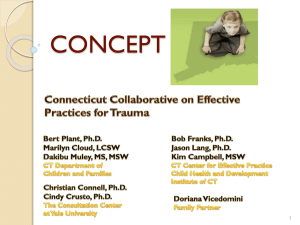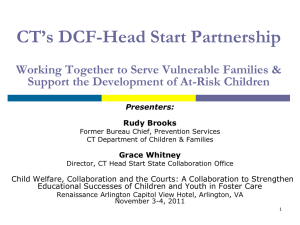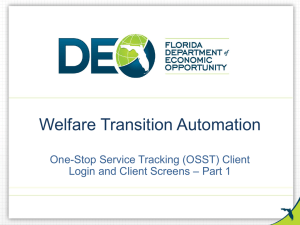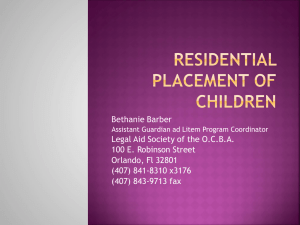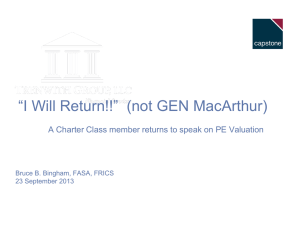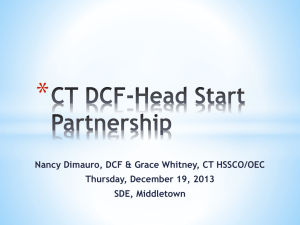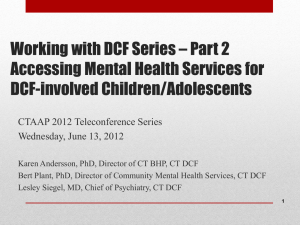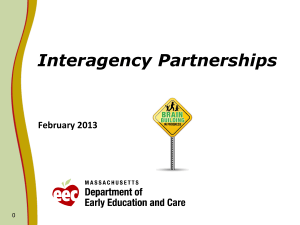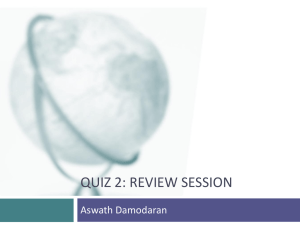Family Assessment
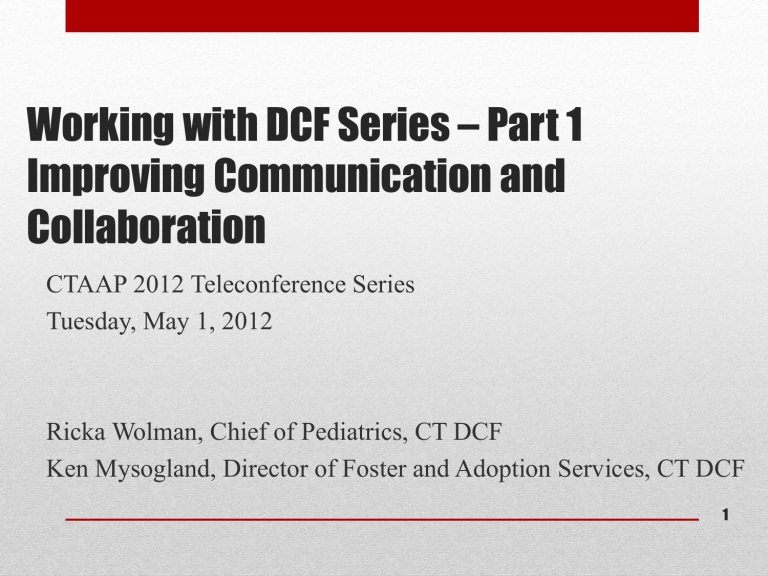
Working with DCF Series – Part 1
Improving Communication and
Collaboration
CTAAP 2012 Teleconference Series
Tuesday, May 1, 2012
Ricka Wolman, Chief of Pediatrics, CT DCF
Ken Mysogland, Director of Foster and Adoption Services, CT DCF
1
•
Introduction by Sandi Carbonari, CT AAP President
• “Working with DCF”: A Series of Teleconferences
•
Improving Communication and Collaboration
•
Models and Strategies for Success
•
Recognizing Physical and Sexual Abuse
•
Foster Care and Mental Health Services
•
(The last two teleconferences may change based on your feedback from the first two and areas of identified interest)
The Goal of the Series
2
Recent Changes at DCF
•
Commissioner Joette Katz
•
De-Centralization
•
Regional Office Re-Structuring
•
Mission and Transformation of the Department
•
6 Cross Cutting Themes
3
DCF Regions
4
•
6 DCF Regions with 2-3 Area Offices in each
•
Each Region has 1 Regional Administrator
•
Each Area Office has an Office Director
•
Each Region has a Clinical Coordinator
•
Each Region has a Systems Coordinator
•
Each Region has a Quality Improvement Manager
•
Each Region has 2-4 Area Office Nurse(s)
DCF Organizational
Structure: their jobs
5
Mission of the Department
All children and youth served by the Department will grow up healthy, safe and learning, and will experience success in and out of school. The Department will advance the special talents of the children it serves and will make opportunities for them to give back to the community.
6
•
Six Cross-Cutting Themes
• A family-centered approach to all service delivery, reflected in development and implementation of a Strengthening Families
Practice Model and the Differential Response System;
• Trauma-informed practice as related to children and families but also to the workforce that serves them;
•
Application of the neuroscience of child and adolescent development to agency policy, practice and programs;
•
Development stronger community partnerships
•
Improvements in leadership, management, supervision and accountability; and
• Establishment of a Department as a learning organization
Six Cross Cutting Themes
7
•
Developed over the past two years with support from the
Casey Family Programs and Casey Family Services
•
Provides a framework for how the agency will work internally and well as partner with families, service providers, and others to put our mission and guiding principles into action.
•
Incorporates a focus on family strengths and protective factors and draws on the Strengthening Families framework being implemented across the nation.
•
Includes core 5 elements
Strengthening Families
Practice Model:
8
1.
Family-Centered Practice
2.
Purposeful Visits
3.
Family Assessment
4.
Supervision and
Management
5.
Family Teaming Model of
Engagement
Core Elements
9
A Differential Response system
(DRS) allows DCF the flexibility to engage families coming to the agency’s attention via allegations of abuse and neglect in a way that is best suited to the needs of the family.
Differential Response
System (DRS)
10
• Driven by the desire to…
•
Be more family centered in the response to child abuse and neglect reports.
•
Recognize that the adversarial focus is neither needed nor helpful in all cases
•
Better understand the family issues that lie beneath maltreatment reports
•
Engage parents more efficiently to use services that address their specific needs
•
Increase sharing responsibility and accountability for families and communities
Why Differential Response?
11
What is a ‘Differential Response System’?
A major philosophical shift in the way we do our work
Moving from a single response system to a dual response system - both with emphasis on safety, risk and engagement but with different policy and procedural approaches
Applies to low risk reports of abuse or neglect
Includes a Family Assessment Response instead of a traditional Investigation Response
Case can be switched to the Investigative track due to safety issues
12
Family Assessment Response
Serves as a family assessment rather than an investigative gateway to child welfare services
No finding (Substantiated/Unsubstantiated)
Family centered and supportive approach focused on collaboratively identifying and addressing family identified needs
Family transferred to a community agency
Funds were allocated for a provision of community services
13
•
Families are referred to the Careline
•
Who makes referrals?
•
Concerned family members, neighbors, physicians, citizens
•
Mandated Reporters
•
CT General Statute (CGS 17a-101a) :
•
Mandated reporters are required to report, or cause a report to be made, when in their professional capacity, they have
REASONABLE CAUSE TO SUSPECT or believe that a child under the age of 18 has been abused, neglected or placed in imminent risk of harm by a person responsible for the child ’ s care
How does a Family Become Involved with DCF?
14
What is the Careline?
•
The Careline is a single point of entry for all referrals of alleged child maltreatment
•
There is a centralized intake process to increase consistency
•
Staffed 24hr/day; 365 days/yr
•
After-hours investigations
•
On-call assignments for Area Office coverage
•
Conducts initial assessment via phone
•
Make the decision regarding and Investigation
Response or a Differential Response
Careline 1 800 842-2288
15
Traditional Investigation Response
A case is assigned to an Investigator and is responded to in either 2, 24 or 72 hours depending on the safety concerns.
2 hrs: A situation in which failure to respond immediately could result in the death of, or serious injury to, a child
Same day: A report of abuse from a school
24 hrs: A non-life threatening situation which is severe enough to warrant a same or next day response to secure the safety of the child and to access the appropriate and available witnesses
72 hrs: A non-life threatening situation which, because of the age or condition of the child, indicates that a timely response is required
16
Investigation Process
•
Interviews are done with all children in the home, parents, relatives and collateral informants including the reporter, if known
•
All families are asked to sign releases for their medical providers, schools, daycare, etc.
•
As providers you may receive a questionnairethese are importantthey assist us in assessing families. (Making this more user friendly)
•
If DCF has specific medical concerns about a child/parent- we will call provider directly or if you have concerns, please call the social worker directly. (need your help standardizing this piece)
17
After 45 days:
•
A decision to substantiate or un-substantiate the allegations has to be made.
•
Level of risk is determined by the Structured Decision
Making Risk Assessment. Based on that assessment the case is either closed or transferred for ongoing service.
•
Closed cases can also be referred for ongoing community services
•
Once substantiated, perpetrators and those that pose risk to children are put on the DCF Central Registry.
Those placed on the Central Registry are able to appeal that decision
Investigation Process
18
•
Forensic/Investigation
•
Immediate to 72 hour engagement
•
SDM Safety Assessment
•
Non-Voluntary
•
Unannounced home visits
•
Mandatory private interview with children
•
Finding of abuse or neglect
•
45 day involvement
•
Family Assessment
•
5 day window for engagement
•
Voluntary
•
SDM Safety
Assessment
•
Telephone call to the home preferred
•
Planned home visits
•
Child interviews and referral for services at the family’s discretion
•
90 day involvement
How family assessment and forensic approaches differ
19
•
Based on AAP Fostering Connections and Child
Welfare League of America (CWLA) guidelines
•
Care consistent with EPSDT
•
Immunizations guided by ACIP recommendations
•
In all cases; provider recommendations essential for any treatment, vaccinations, etc. Your input is key!
•
Goal: Medical Homes for all children in DCF’s care. Outcome: Improved health and well-being
DCF Medical Policy: Guidelines for
Care based on national standards
20
•
Complete form from Investigations: ‘Request for Medical
Information’
•
Initial Medical Screen (when needed)
•
Multidisciplinary Evaluation (MDE) by 30 days
•
Recommendations and follow-up
•
Development of Treatment Plan
•
Administrative Case Review (ACR)
•
Periodic Visits consistent with AAP & CWLA guidelines
•
Discharge from care / transfer of providers
Components of DCF’s Medical
Policy and Practice:
21
•
96 hour hold
•
Order of Temporary Custody (OTC)
•
Granted by the court
•
DCF becomes the legal custodian but parent remains the legal guardian: parents give consent but DCF can authorize necessary medical care
•
Commitment
•
DCF is legal custodian and guardian
•
DCF consents for medical treatment
•
Termination of Parental Rights
•
Note: Whenever feasible, DCF keeps parents involved
Children in DCF Care & Your Office:
Definitions and who can sign for what?
22
•
Permission to Deliver or Obtain Routine Health Care:
(460a) This is for PCPs and Primary Care! Signed by
DCF if child is committed/signed by parent if OTC
•
Informed Consent for Necessary or Emergency Health
Care: (460) This is for specialty care/surgery etc. Signed by DCF manager if child is committed. If complex or unusual care may be referred to DCF Chief of Pediatrics or Medical Review Board (MRB) for review
•
Psychotropic Medication Consent Request (465)
•
Links to policy and forms included on final slide
•
Who to call if you are having problems!
Consents and Permission to Treat:
Who Can Sign?
23
•
You may already have received a request for information from investigations
•
Someone familiar with the child (foster parent, social worker, caregiver) accompanies them
•
This individual provides you with a signed “Permission to obtain and provide Routine Medical Care” (who signs it depends on the legal status: committed, OTC etc)
•
Caregiver has the ‘Health Passport ‘ *
•
You complete the ‘Report of Health Visit’ form and provide caregiver with a copy *
•
Improving collaboration: Requesting f/u from DCF staff (new language and expectations)
What to expect when a child in DCF’s care visits your office
24
* In Draft but should be finalized by next teleconference
•
Health Passport
•
Medical Alert (based on AAP/AAEP CYSHCN form)
•
Immunization record
•
Signed “Permission to Deliver or Obtain Routine Health
Care”
•
Report of Health Visit
•
Request for medical records: limiting these requests (making best use of this information)
•
Routine requests for updates re medical status for children in our care (the timing and f/u)
Health Passport (and other paperwork)
25
• Mandated reporters are required to make a referral to the DCF Hotline as soon as practical but no later than 12 hours after the mandated reporter becomes aware of or suspects abuse/neglect or imminent risk of serious harm to a child or children.
• Any person required to report who fails to make such report or fails to make such report within the time period prescribed (in sections 17a-101b to 17a-101d), could be fined not less than five hundred dollars ant not more than two thousand five hundred dollars and could be required to participate in an educational and training program (pursuant to subsection
(d) of section 17a-101).
•
The Department shall promptly notify the Chief State's Attorney when there is reason to believe that any such person has failed to make a report in accordance with this section.
Your responsibilities as a m andated reporter: the regulations
26
•
DCF provides Mandated reporter training to all providers in the state of Connecticut upon request.
•
Information regarding Mandated Reporter training for your organization, agency, or facility;
(link provided on final slide)
•
DCF supported “Child Abuse Specialists”; consultation, training, referral for evaluation
How DCF can support you in your role as a mandated reporters
27
•
Improving Collaboration: Regional meetings with DCF staff and you!
•
Establishing “Medical Homes” for children in our care: what does this mean?
•
Our next teleconferences: topics and goals
•
Please send us your feedback, questions and topics you want addressed
Next Steps
28
•
DCF Region Contact Information and Chain of
Command (link)
•
DCF Policy: Informed Consent policy and forms
•
Health Passport
•
Mandated reporter information
Resources
29
30
